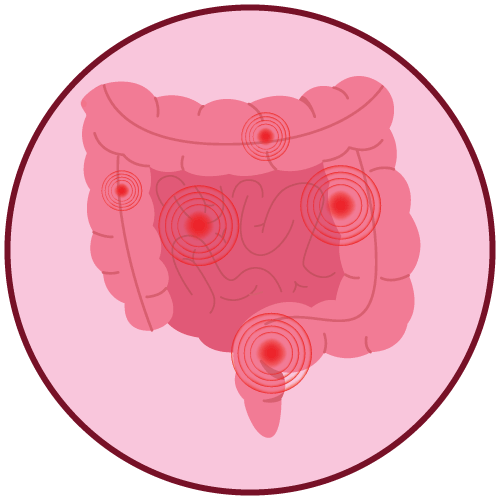| Name | Chronic Malabsorption Syndrome |

Chronic Malabsorption Syndrome
Chronic malabsorption syndrome refers to a group of disorders characterised by the impaired absorption of nutrients from the gastrointestinal tract over an extended period. This condition can lead to deficiencies in essential nutrients such as proteins, fats, carbohydrates, vitamins, and minerals. Here's some information on the causes, signs and symptoms, diagnosis, and potential treatments for chronic malabsorption syndrome:
Causes:
- Gastrointestinal disorders: Conditions such as celiac disease, Crohn's disease, ulcerative colitis, or microscopic colitis can damage the lining of the intestines and affect nutrient absorption.
- Pancreatic disorders: Chronic pancreatitis, pancreatic insufficiency, or pancreatic cancer can disrupt the production and release of digestive enzymes necessary for nutrient digestion and absorption.
- Bile duct disorders: Blockages or abnormalities in the bile ducts, such as gallstones or primary biliary cirrhosis, can impair the secretion of bile needed for fat absorption.
- Small intestine disorders: Conditions like small intestinal bacterial overgrowth (SIBO), intestinal parasites, or surgical removal of a portion of the small intestine can interfere with nutrient absorption.
- Genetic disorders: Inherited disorders like cystic fibrosis or certain enzyme deficiencies can result in chronic malabsorption.
Signs and Symptoms:
- Diarrhea, which may be bulky, greasy, and foul-smelling.
- Weight loss and malnutrition.
- Abdominal pain, bloating, or cramping.
- Fatigue and weakness due to nutrient deficiencies.
- Vitamin and mineral deficiencies, leading to symptoms like anemia, bone abnormalities, or neurological problems.
Diagnosis: Diagnosing chronic malabsorption syndrome involves a thorough evaluation by a healthcare professional. The following diagnostic tools may be used:
- Medical history and physical examination: Discussing symptoms and medical history can provide valuable information.
- Blood tests: Blood tests can assess nutrient levels, check for deficiencies, and detect specific markers related to malabsorption.
- Stool tests: Stool samples may be analyzed for fat content, presence of parasites, or signs of inflammation.
- Imaging studies: X-rays, computed tomography (CT), or magnetic resonance imaging (MRI) scans can help evaluate the gastrointestinal tract for structural abnormalities.
- Endoscopic procedures: Procedures like an upper endoscopy, colonoscopy, or capsule endoscopy may be performed to visualize the intestinal lining and collect biopsy samples for further analysis.
Treatment:
The treatment of chronic malabsorption syndrome depends on the underlying cause and may include:
- Dietary modifications: Following a specific diet plan recommended by a healthcare professional, such as a gluten-free diet for celiac disease or a low-fat diet for pancreatic insufficiency.
- Nutritional supplements: Supplements may be prescribed to address specific nutrient deficiencies.
- Medications: Medications can be used to manage symptoms, control inflammation, or address underlying conditions.
- Enzyme replacement therapy: For pancreatic insufficiency, pancreatic enzyme supplements can be taken to aid in digestion and absorption.
- Management of underlying conditions: Treating the specific disorder causing malabsorption is essential for long-term management.
It's crucial to consult a healthcare professional for an accurate diagnosis and individualized treatment plan based on the underlying cause of chronic malabsorption syndrome. They can provide appropriate guidance and monitoring to manage the condition effectively.
 Bangla
Bangla English
English